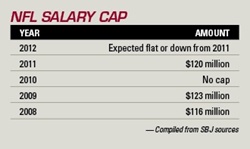NFL team executives were working late last week to prepare for a new league year that, according to multiple football sources, could bring a salary cap that’s flat or less than last year but where the total amount of money the clubs pay to players still increases from 2011.
That increase would come from non-salary items like workers’ compensation payouts, pensions and performance pay, something that was not in effect in 2011, the first year of the new 10-year collective-bargaining agreement.
The league and NFL Players Association were negotiating last week over the size of the cap. Both parties declined to comment, though league officials as of Thursday said a decision on the cap appeared imminent.
The talks, in addition to setting up teams’ business decisions for 2012, come as the union is preparing for its annual meeting later this month. DeMaurice Smith’s three-year contract as NFLPA executive director expires March 14, according to the NFLPA’s annual report filed with the Department of Labor, and while it is widely presumed that Smith is running for a second term, he has not publicly acknowledged that he will do so. The NFLPA did not reply for comment on this point.
 |
Derrick Brooks would consider a bid for the NFLPA’s top spot, sources said, if he were nominated by the players.
ICON SMI |
No candidate has publicly emerged to run against Smith, but sources said retired 11-time Pro Bowl linebacker Derrick Brooks would seriously consider running if player leadership made clear that competition for the job was welcome.
“Derrick is not openly campaigning, but if his name was nominated by the players, he would take a long, hard look at this opportunity,” one source said.
Brooks, though his agent, Peter Miller, declined to comment. Brooks is currently the president of the AFL Tampa Bay Storm. He was an NFLPA player representative in 2009 when Smith was elected and oversees a host of charitable endeavors in Tampa.
NFLPA player leaders are expected to elect new members of the group’s executive committee, which is the core player-leadership group, when they meet in Florida later this month. A vote for executive director could be taken at that time, as well.
The 32 team player representatives vote for the executive committee and also the executive director. Whether the level of the cap will be an issue at that meeting is unknown.
As for the cap and its possible decline from $120 million per club last year, one reason for a potential decline is that performance pay for players with low salaries who perform well on the field may return in 2012 after disappearing in year one of the CBA. That deletion came in the context of negotiating the new labor deal. In the past, under the old CBA, performance pay averaged about $4 million per club. This money, distinct from incentive pay that is worked into contracts, is paid to players with below-average salaries after a season for performing beyond expectations. Those dollars do not count toward the salary cap, so the league may be negotiating to lower the cap in part to account for performance pay. Also, according to team sources, human-resource benefits were rising faster than revenue, and workers’ compensation payouts have been high (see related story).
These non-salary items count toward total player compensation and often total about $20 million annually per club, though they were somewhat less in 2011 because of the absence of performance pay.
If these non-salary items are rising, then the league, sources said, wants to take some of that out of the cap.
Another factor contributing to a potential cap decline is that overall player compensation is based on a percentage of revenue. The league, however, has a number of revenue deductions that it can take in the CBA, and setting the cap requires projecting local revenue, which one source described as soft in 2012 in part because of flattening ticket prices.
If the projection proves in error, the cap is then adjusted to account for the difference the following year.
Flat caps and soft local revenue may seem contrary to the news of sky-high TV ratings and the league’s massive new media deals, but those contracts do not kick in until 2014. Under terms of the new CBA, which divided revenue into different categories, players will get 55 percent of media revenue.
Starting in 2013, teams are required to spend to at least 89 percent of the cap, and in cash. Currently, the league must average 99 percent in cash, but there is no team requirement. That means a bonus that is paid this year may be amortized over the life of the contract for cap purposes and fully count toward this year’s league-spend requirement.
Some of these apparent issues in the CBA for players were raised prior to the Super Bowl by David Cornwell, one of three candidates in 2009 whom Smith defeated for his position. Cornwell, a player lawyer, sent a memo to agents criticizing the executive director over the new CBA. His criticisms included that players were getting less than they were led to believe.
Cornwell last month was named executive director of the NFL Coaches Association.
Asked about Cornwell’s memo at the Super Bowl, Smith replied that critics are entitled to their opinion but not their own “facts,” and outgoing NFLPA player President Kevin Mawae slammed Cornwell as well, stating that he ran for executive director in 2009 without the blessing of the executive committee. Cornwell had the support of three player representatives, which was the minimum needed to run under the union’s rules.
That distinction speaks to Brooks’ standing, wanting to see if union leadership wants the CBA and Smith’s tenure open to debate from a rival for the job.




